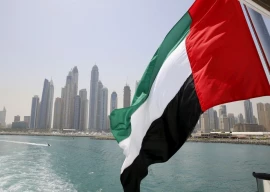In desperation, he went to Sri Lanka where he found Ar C. Anjalendran. “I could not believe how anyone could not get involved in this project,” the architect said during his presentation at IAPEX in Karachi on Friday. The site was slap bang up against what Anjalendran described as one of the most beautiful monuments in South Asia: Masoom Shah jo munaro or the minaret built 400 years ago by a Mughal diplomat fondly called Mir Masoom Shah Masoomi.
The outcome was the ICON Ghouri departmental store in an earthy red that uses lattice work or double screens to beat the temperatures by making the hot air flow up and out. It is perhaps the only shopping mall in Sindh that doesn’t have a glass front. Anjalendran learnt later that while the men of Sukkur didn’t necessarily take to it because it didn’t look like a Dubai building, the women have surprisingly liked it because of the security and privacy it offers.
The decision to take this project, in part, exemplifies Anjalendran’s approach. His mentor Geoffrey Bawa, regarded as one of the most important and influential Asian architects of the twentieth century, had showed him how they could eschew the monumental or iconic, which are non-egalitarian and prefer the ordinary or vernacular. “In simple terms, there is always too much architecture between me and the view,” Anjalendran said, bringing up the Dubai example. “Never do architecture that is iconic or in your face. Respect nature. Show restraint,” he urged throughout his presentation.
Anjalendran is familiar with Pakistan where he was invited 18 years ago by AR Akeel and Noorjehan Bilgrami. One of his more famous works here is the residence of Nighat and Imran Mir. In the panel discussion, the local architect who collaborated with him, Ar Shahid Abdulla, recalled how Imran Mir’s brief had been specific: I don’t want it to look like it’s been designed by you. The architects understood that he wanted an effortless, organic look.
That was, happily, Anjalendran’s forte and today the residence’s focus is its two Champa trees and other foliage. “It is not a house that looks outward, all the windows look at trees,” explained Anjalendran.
For him it has been essential to work with the landscape. “The formalism doesn’t destroy the organic object,” he said. “There is always respect for nature… man-made rock joins natural rock.” He showed examples of breathtaking water gardens in his country that are hundreds of years old. And it has been important to maintain the sense of tranquility, he said. After all, until quite recently, Sri Lanka was a country at war. “If you have a tree, it is the equivalent to an air conditioner,” he quipped. “A Banyan tree is worth three air conditioners.”
Published in The Express Tribune, April 14th, 2012.























COMMENTS
Comments are moderated and generally will be posted if they are on-topic and not abusive.
For more information, please see our Comments FAQ